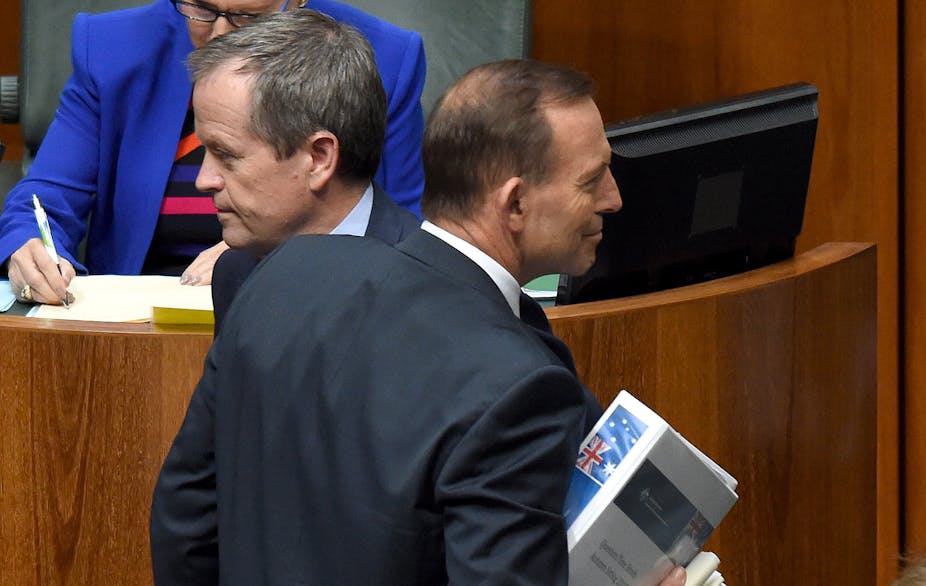Economists disappointed by last week’s desultory federal budget and Bill Shorten’s “me too” reply may get some satisfaction by talking to their political science colleagues. For one of the most venerable scholarly theories of Australian politics appears to be making a comeback.
The “convergence thesis” – which holds that the main Australian political parties will, over time, converge upon near-identical policy positions on most issues – was on full display last week.
The Coalition government did a convincing job of producing a Labor budget, with some sops to small business, while the opposition did its best to promise more of the same, unfunded. Credible plans for a balanced budget and the much more demanding task of intergenerational equity were studiously ignored by both sides.
Media commentators often see this as the failings of our “political class” to step up to the challenges of leadership, and there is definitely some truth to that.
But there are underlying systemic pressures towards convergence that are particularly strong in Australia.
Vote 1 for the same ideas
Start with the presumption that politicians are fundamentally “office-seeking” in their behaviour. In other words, their prime motivation is to attain and hold on to power, not necessarily to do anything with it. Think Kevin Rudd and, it appears, Tony Abbott.
To achieve office (that is, a role in government, not just a seat in parliament) politicians need “catch all” parties, such as the modern Liberal and Labor machines. These parties are fundamentally electoralist in nature: their key purpose is to win elections, not to mobilise social groups or bring about social change.
Winning elections requires a focus on the “median voter” – the voter who sits at the exact centre of the political and policy spectrum, and thus offers the best target for election campaigning.
Median voters are assumed to be self-interested, short-sighted and conservative, but also rational, family-focused and personally aspirational. This is common to many developed democracies.
The power of preferences and compulsory voting
In Australia, two additional and near-unique electoral institutions – compulsory voting and a preferential ballot – make pressures for convergence even more powerful.
Compulsory voting drags to the polls the 30% or so of the electorate who couldn’t care less about politics. They would not choose to vote unless they had to.
This group essentially decides election outcomes, making it much harder for parties to adopt longer-term reforms that could alienate what political professionals call “low-information voters”.
In the polling booth, compulsory preference marking catches the votes of these and other groups – including highly engaged voters – who support minor parties. These votes are then funnelled back to the two major parties, assuming that they can still gain sufficient first-preference support, in a process that encourages policy aggregation rather than differentiation.
Reform is possible – with bipartisanship
Centralist politics does not necessarily mean that the status quo prevails. With bipartisan parliamentary support, such a system can enable serious reform to occur, as was the case for the Hawke-Keating years.
Our current lack of bipartisanship, which owes a lot to the way Abbott conducted himself as opposition leader, makes a repeat of this period much harder.
Parties do maintain a few talismanic distinctions to retain the distinctiveness of their brands. Attitudes towards industrial relations and immigration remain politically salient for voters, for instance, and hence are likely to be the focus of efforts to distinguish themselves by the parties too.
Other issues that were previously a model of convergence, such as Israel-Palestine, are becoming less so, in part due to demographic changes in marginal seats in Western Sydney.
However, longer-term challenges such as government debt, intergenerational equity and climate change are increasingly being placed in the too-hard basket by both parties.
A simple step to deliver greater choice
Convergence is not necessarily bad. It helps Australian politics avoid the extremes seen in the United States, for instance, and forces the parties to keep a constant watch on bread-and-butter issues. But it also makes serious policy debate extremely difficult, as both parties seek to avoid or neutralise issues that do not resonate with the median voter.
To the extent that convergence is a problem – which will only become clear when the next exogenous shock hits Australia, such as another Global Financial Crisis or El Niño drought – we should consider some modest institutional reforms to encourage more genuine political competition.
A simple one would be to switch to an optional preferential voting system for the House of Representatives, as has been proposed but not yet legislated for Senate elections. Voters in New South Wales and Queensland state elections already have the option to exercise as many, or as few, of their preferences as they choose.
The consequences of this federally would be significant. Both major parties would have to fight much harder for preferences if these were optional and they had to differentiate themselves from their competitors rather than imitating them.
A switch to optional preferential voting would also address the growing problem of informal voting – almost 6% of all votes at the last federal election, most due to numbering errors.
But it would also open the question of why, if we don’t need to compel voters to express preferences that they do not in fact have, we should compel them to vote at all.
While some Liberals have intermittently expressed interest in ending compulsory voting, this is not a conversation either of the major parties wants. It would require political courage, something in very short supply at the moment.

